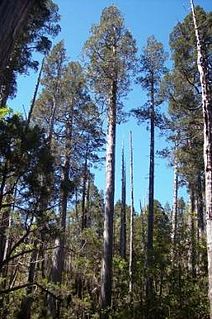
Sciomyzoidea is a superfamily of Acalyptratae flies.

The Coelopidae or kelp flies are a family of Acalyptratae flies, they are sometimes also called seaweed flies, though both terms are used for a number of seashore Diptera. Fewer than 40 species occur worldwide. The family is found in temperate areas, with species occurring in the southern Afrotropical, Holarctic, and Australasian regions.

The Antarctic Floristic Kingdom, also the Holantarctic Kingdom, is a floristic kingdom that includes most areas of the world south of 40°S latitude. It was first identified by botanist Ronald Good, and later by Armen Takhtajan. The Antarctic Floristic Kingdom is a classification in phytogeography, different from the Antarctic realm classification in biogeography, and from Antarctic flora genera/species classifications in botany.
Axymene aucklandicus is a species of predatory sea snail, a marine gastropod mollusc in the family Muricidae, the rock snails or murex snails.
Aphrosylopsis is a genus of flies in the family Dolichopodidae. It is endemic to the Bounty Islands of New Zealand. It contains only one species, Aphrosylopsis lineata.

The Helosciomyzidae are a small family of flies - 9 genera and 22 species. All are known from the Southern Hemisphere. With the exception of the South American genus Sciogriphoneura, the family occurs in Australia, New Zealand. Little is known of their biology.

The Helcomyzidae are a small family of flies in the Acalyptratae. The larvae feed on kelp and other organic matter washed up on shorelines. Species diversity is highest in New Zealand and south temperate South America. They are sometimes allied with the families Dryomyzidae or Coelopidae.
Apetaenus is a genus of beach flies in the family Canacidae. They are endemic to the subantarctic archipelagos in association with colonies of penguins and other seabirds. Some species have vestigial wings.

Australimyzidae is a family of flies (Diptera). There is 1 genus, containing 9 known species known from Australia and New Zealand and subantarctic surrounding islands. They have saprophagous larvae.

Hydrophorinae is a subfamily of flies in the family Dolichopodidae. According to Germann et al. (2011), the subfamily is polyphyletic.

Chaetocoelopa littoralis, commonly known as the hairy kelp fly, is a fly of the family Coelopidae. It is endemic to New Zealand. These flies are black in appearance and show large variation in size, with males tending to be larger and more robust and 'hairy' than females. C. littoralis can also be observed resting on surfaces including cliff faces and driftwood in large aggregations.

This is a genus of kelp fly in the family Coelopidae. As of 2017, it is monotypic, consisting of its type species This canus. This and T. canus were respectively circumscribed and described in 1991 by the Australian entomologist David K. McAlpine. It is endemic to southern Australia.
Coelopina is a genus of kelp flies in the family Coelopidae.
Chaetocoelopa is a genus of kelp flies in the family Coelopidae.
Beaopterus is a genus of kelp fly in the family Coelopidae.
Coelopella is a genus of kelp flies in the family Coelopidae.
Coelopellini is a tribe of kelp flies in the family Coelopidae.
Coelopinae is a subfamily of kelp flies in the family Coelopidae.

Sciapodini is a tribe of flies in the family Dolichopodidae.










